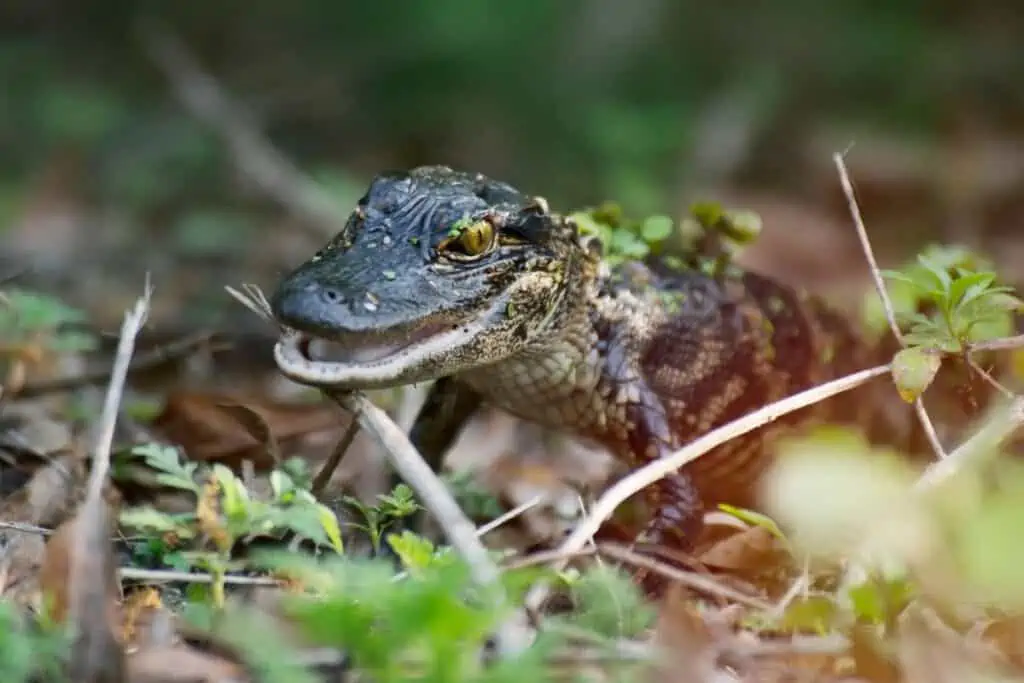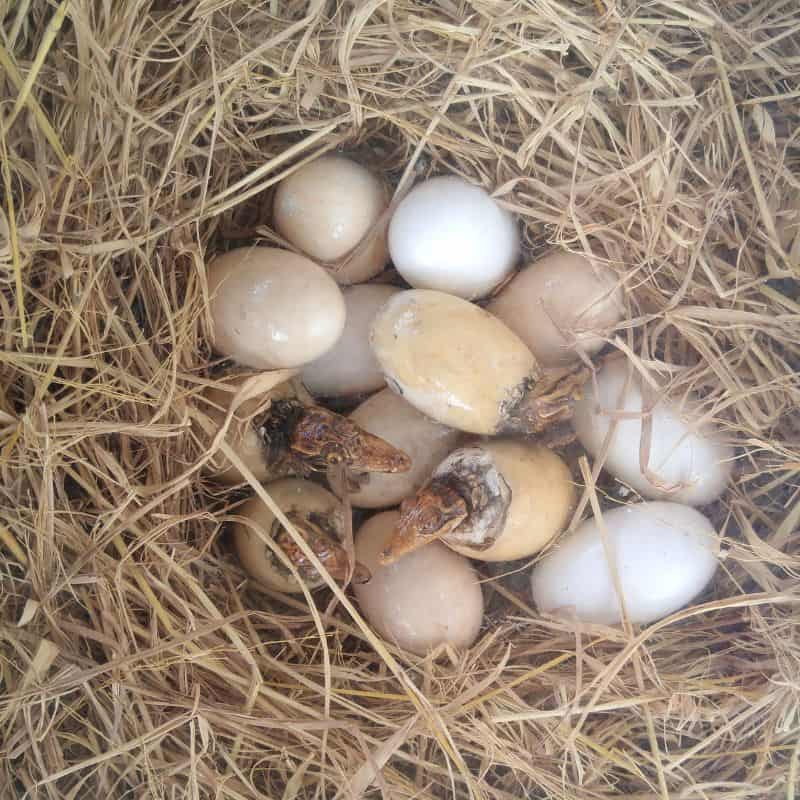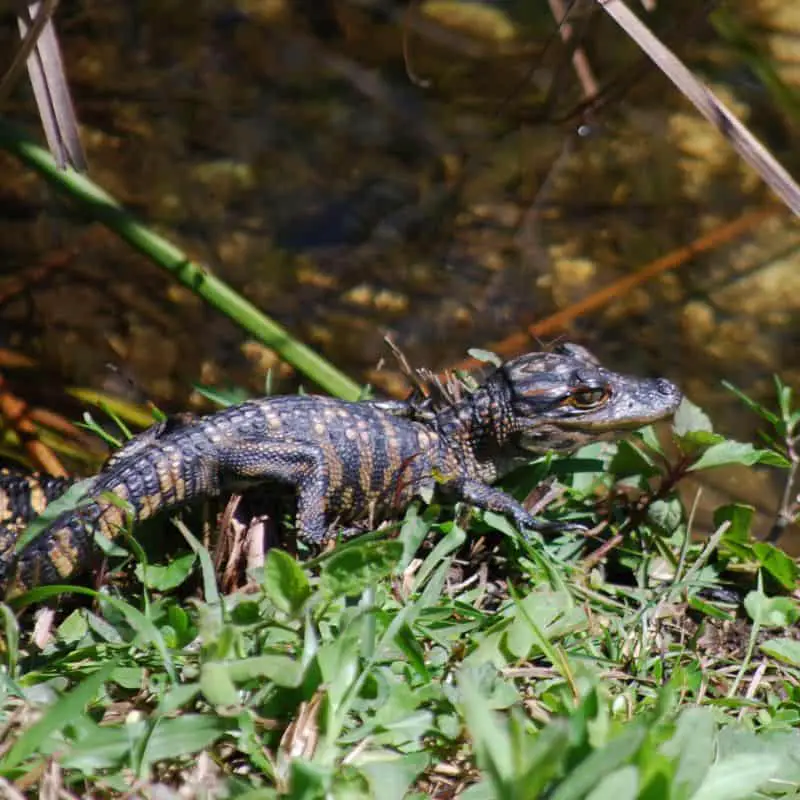Reptiles are seldom described as adorable. But with their tiny wiggly bodies and squeaky noises, you have to admit baby alligators are way too cute! You may not want to touch or befriend them for life, but you must love a baby, even a reptilian one.
The correct term for a baby alligator is a hatchling. They live in a nest with the rest of their pod, consisting of the mother alligator and other hatchlings, for about a year. When they hatch after approximately two months, they weigh about two ounces and measure six to eight inches long.
At one stage, American alligators were on the brink of extinction. But twenty years after being placed on the endangered species list in 1967, there were baby alligators galore, and they were removed from it.
Let’s look at some more interesting facts about these cute critters.

- 1. The Life And Times Of A Baby Alligator
- 2. Life As An Egg
- 3. Baby Alligators Become Juveniles
- 4. The Appearance Of A Baby Alligator
- 5. The Habitat Of Alligators
- 6. The Diet Of Alligator Hatchlings
- 7. The Natural Predators Of Baby Alligators
- 8. The Behavior Of Baby Alligators
- Final Thoughts On Baby Alligators
1. The Life And Times Of A Baby Alligator
Hatchlings usually stay with their mothers for about a year, sometimes as long as three years. The longer, the better because she helps protect them from predators.
Alligators are considered “babies” until they reach about six feet in length, which is a big baby.
But let’s begin at the beginning of the little critters’ lifecycles.
2. Life As An Egg
Mom alligators make their nests on the banks of marshes and other freshwater bodies with mud, dried grass, sticks, and other plant matter.
They lay between twenty and fifty eggs at a time and then cover the eggs with plants to incubate the eggs. The large white eggs are slightly bigger than chicken eggs.
Baby alligators hatch in their shells in June or July after about two months.
Like baby crocodiles, they start making peeping noises just before they’re ready to break out. They do this to call their mothers to the nest to remove the vegetation for the hatching process.

The calling also synchronizes the hatching of sibling alligator babies.
Temperatures at the nest will decide the gender of the hatchlings. Males come from nests with temperatures of 90 to 93°F.
Temperatures between 82 and 86°F produce female hatchlings, while anything between 82 and 90°F will result in a litter of both genders.
3. Baby Alligators Become Juveniles
The mother takes them down to the water when the babies emerge from the eggs. Sometimes she will carry them in her mouth or let them ride on her back while swimming.
The hatchlings will stay in their pods, close to their mothers, while in the water. They find some protection in the pod and will squeak to get the mother’s attention if they feel threatened.
Few predators will be brave enough to prey on hatchlings with a mother alligator in the vicinity.
Mothers will protect their young for up to a year, but they must prepare for the next batch of hatchlings. The juveniles also begin to compete with the mothers for resources, which probably sours the relationship a little.
4. The Appearance Of A Baby Alligator
Let’s take a step back here and inspect the newly hatched babies. They emerge from the eggs snapping their jaws. The hatchlings are six to eight inches long and weigh around two ounces.
They are greenish-black or black, with yellow stripes on their backs and sides. The stripes fade gradually over weeks. All siblings from a nest will have similar markings.
Alligators’ colors will also depend on the water they live in. Water full of algae will result in gators with a greenish tinge. In contrast, darker ones will come from waters with a tannic acid content from overhanging vegetation.

Baby alligators are also born with a mouth full of teeth, probably between sixty and eighty razor-sharp little gnashers.
One of those teeth is called a caruncle, or egg tooth, which they use to break out of their shells. It falls out soon after hatching.
Young alligators will grow approximately a foot per year for the first few years. Growth then slows down. The males don’t stop growing, though.
A helpful hint if you find yourself in the dark in alligator territory is that smaller alligators’ eyes will glow green when you shine a light at them. The bigger gators have red glowing eyes.
5. The Habitat Of Alligators
Baby alligators live in the nest with their mothers and siblings until they are about a year old.
In America, alligators are found in Texas, Louisiana, North Carolina, South Carolina, and Florida.
Most live in coastal marshes but can also be found in lakes, canals, rivers, and bayous.
6. The Diet Of Alligator Hatchlings
Alligators are carnivorous; babies live on shrimp, bugs, flies, snails, and small fish. True to their alligator nature, they eat almost anything that fits their mouths.
They are not fussy eaters. They may even eat each other at later stages of their lives.
As they grow, the young reptiles will expand their menu to include more extensive offerings such as crabs, small birds, and frogs.
Alligators are not energetic hunters. Instead, they are lurking opportunists that will grab anything that happens by for a snack.
Alligators will eat as often as they can, but because they are cold-blooded, they can survive long periods without food.
Adults often only eat about once a week; in winter, they go dormant, without food for months.

7. The Natural Predators Of Baby Alligators
The mother alligator is one of the most caring and protective reptiles. She protects her babies from predators, which include bobcats, birds, raccoons, snakes, otters, large bass, and older alligators, to name a few.
When young alligators have grown to about four feet long, they are considered independent and able to protect themselves from most predators, except larger gators.
8. The Behavior Of Baby Alligators
Baby alligators are noisy little creatures. They make squeaking noises before they have even hatched, calling their mothers to uncover the eggs, or when they are scared, hungry, or have any other needs.
Their sound has been compared to laser guns in a video game or puppy and kitten sounds.
Little alligators are docile, although their mothers can get aggressive if you come too close to them! Hatchlings have sixty to eighty teeth; although the babies aren’t dangerous, their bites can be pretty sharp.
If we’re talking about the bigger “babies” under six feet in length, it’s best to keep your distance. Their jaws have a strong grip, and they can rip parts of limbs or small prey apart by doing the death roll, shaking the prey around in their mouths until it breaks into edible pieces.
Baby and adult alligators like to play. This has been determined through scientific research and observation.
Vladimir Denits, a psychology professor from the University of Tennessee, concluded this from years of studying and observing crocodilians.
Denits states that crocodilians, which include alligators, engage in all three types of play listed by behaviorists: locomotor play, social play, and play with objects. An example of locomotor play is seeing juvenile alligators sliding down slopes repeatedly.
He also observed them playing with wooden balls, broken ceramics, their prey, or marsh debris, tossing it up in the air.
During his studies, Dinets also spotted an alligator playing with an otter. There have been many reports of alligators making friends with people or being kept as pets.
It should be noted that although these reptiles can be friendly with humans, they are wild and should not be trusted not to snag another pet or small child for a snack. This applies especially to the bigger “babies.”
Final Thoughts On Baby Alligators
Who knew that a baby alligator could be up to six feet long? It gives new meaning to the term “baby.”
Hatchlings fit the description better, and they are cute, noisy little creatures, depending on their mothers for approximately a year until they are sent into the big wide world on their own.
Research indicates that these animals enjoy social play, but that doesn’t always apply to humans, so I will respect that gorgeous smile, wave to them from a distance, and say, “see ya later, alligator!”


wow
😃